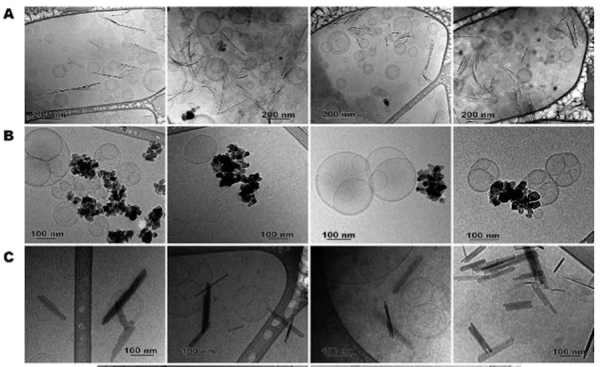 From analyses of bacterial microfossils, (some of which may be up to 3.48 billion years old) we know that the most primitive life was nearly as complex as today’s bacteria. Unfortunately, the (micro)fossil record can’t really tell us how we got from the simple chemicals to living, working, bacterial cells. In their 2017 publication in Scientific Reports, ISO fellow Dr. Nita Sahai, her lab, and her colleagues take a crack at bridging the gap between those simple chemical compounds from early Earth, and what we recognise as cells. Specifically, they want to know about how protocells could form- protocells being cell-sized bubbles made out of lipids that can hold a few biologically useful molecules inside, but are still not quite a cell. Sahai’s team’s challenge is to explain how such a structure could spontaneously assemble itself. In their paper, Sahai and her colleagues look at specific physical properties that result from the physical and chemical interactions of these cell-like lipid bubbles with early Earth-like chemical environments to try and see if any combination of these factors could get protocells to naturally, spontaneously, form.
From analyses of bacterial microfossils, (some of which may be up to 3.48 billion years old) we know that the most primitive life was nearly as complex as today’s bacteria. Unfortunately, the (micro)fossil record can’t really tell us how we got from the simple chemicals to living, working, bacterial cells. In their 2017 publication in Scientific Reports, ISO fellow Dr. Nita Sahai, her lab, and her colleagues take a crack at bridging the gap between those simple chemical compounds from early Earth, and what we recognise as cells. Specifically, they want to know about how protocells could form- protocells being cell-sized bubbles made out of lipids that can hold a few biologically useful molecules inside, but are still not quite a cell. Sahai’s team’s challenge is to explain how such a structure could spontaneously assemble itself. In their paper, Sahai and her colleagues look at specific physical properties that result from the physical and chemical interactions of these cell-like lipid bubbles with early Earth-like chemical environments to try and see if any combination of these factors could get protocells to naturally, spontaneously, form.
 Excitingly, they find that, under the right conditions, certain minerals (the dark spots on the image to the left) catalyze the formation of vesicles (the lipid-bubbles) and conclude that minerals, perhaps found at a water-sediment interface, could have influenced the initial self-assembly of a protocell membrane. Furthermore, Sahai and her colleagues believe that the vesicle-mineral physical properties they identify should help predict protocell membrane formation not only on Earth, but also on the Moon and other worlds, as soon as those other worlds’ minerality is known. Incredible as it may seem, chasing the origins of life on Earth can bring us greater knowledge of possible alien life forms- even without leaving our planet!
Excitingly, they find that, under the right conditions, certain minerals (the dark spots on the image to the left) catalyze the formation of vesicles (the lipid-bubbles) and conclude that minerals, perhaps found at a water-sediment interface, could have influenced the initial self-assembly of a protocell membrane. Furthermore, Sahai and her colleagues believe that the vesicle-mineral physical properties they identify should help predict protocell membrane formation not only on Earth, but also on the Moon and other worlds, as soon as those other worlds’ minerality is known. Incredible as it may seem, chasing the origins of life on Earth can bring us greater knowledge of possible alien life forms- even without leaving our planet!
